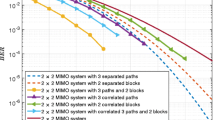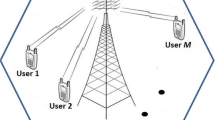Abstract
A new differential space-time code, called differential space-time block-diagonal code (DSTBDC), is proposed for multiple-input multiple-output (MIMO) wireless communication systems. By exploiting the block-diagonal construction of DSTBDC, we can design a variety of high-performance DSTBDC, especially for the cases of large numbers of transmit antennas and high date rates. In flat fading channels, DSTBDC outperforms traditional differential space-time codes if the data rate is higher than 1 bps/Hz, especially when the number of transmit antennas is large. In frequency-selective fading channels, multiple-input multiple-output orthogonal frequency-division multiplexing (MIMO-OFDM) systems using DSTBDC have the powerful ability to achieve very high diversity gain in space, time, and frequency simultaneously. Due to the special orthogonal construction, DSTBDC has a simple decoding algorithm. In addition, DSTBDC can significantly save the cost of radio frequency circuits.
Similar content being viewed by others
References
Telatar I E. Capacity of multiantenna Gaussian channels. Euro Trans Telecommun, 1999, 10(6): 585–595
Foschini G J. Layered space-time architecture for wireless communication in a fading environment when using multi-element antennas. Bell Labs Tech J, 1996, 1(2): 41–59
Tarokh V, Seshadri N, Calderbank A R. Space-time codes for high data rate wireless communication: performance criterion and code construction. IEEE Trans Inf Theory, 1998, 44(2): 744–765
Alamouti S M. A simple transmit diversity technique for wireless communications. IEEE J Select Areas Commun, 16(8): 1451–1458
Tarokh V, Jafarkhani H, Calderbank A R. Space-time block codes from orthogonal designs. IEEE Trans Inf Theory, 1999, 45(2): 1456–1467
Su W, Xia X G. On space-time block codes from complex orthogonal designs. Wirel Pers Commun, 2003, 25: 1–26
Gesbert D, Shafi M, Shiu D, et al. From theory to practice: an overview of MIMO space-time coded wireless systems. IEEE J Select Areas Commun, 2003, 21(3): 281–302
Tarokh V, Jafarkhani H. A differential detection scheme for transmit diversity. IEEE J Select Areas Commun, 2000, 18(7): 1169–1174
Hughes B L. Differential space-time modulation. IEEE Trans Inf Theory, 2000, 46(7): 2567–2578
Hochwald B M, Marzetta T L. Unitary space-time modulation for multiple-antenna communication in Rayleigh flat fading. IEEE Trans Inf Theory, 2000, 46(2): 543–564
Hochwald B M, Sweldens W. Differential unitary space-time modulation. IEEE Trans Commun, 2000, 48(12): 2041–2052
Clarkson K L, Sweldens W, Zheng A. Fast multiple antenna differential decoding. IEEE Trans Commun, 2001, 49(2): 253–261
Shokrollahi A, Hassibi B, Hochwald B M, et al. Representation theory for high-rate multiple-antenna code design. IEEE Trans Inf Theory, 2001, 47(6): 2335–2367
Zou L, Zhao Y, Wang B, et al. Dual constellations space-time modulation. Sci China Ser F-Inf Sci, 2005, 48(4): 452–466
Liu Z, Giannakis G B. Block differentially encoded OFDM with maximum multipath diversity. IEEE Trans Wirel Commun, 2003, 2(3): 420–423
Stuber G L, Barry J R, McLaughlin S W. Broadband MIMO-OFDM wireless communications. Proc IEEE, 2004, 92(2): 271–294
Stuber G. Principles of Mobile Communication. Boston, MA: Kluwer, 2001
Author information
Authors and Affiliations
Corresponding author
Additional information
Supported by the National 863 Program of China (Grant No. 2003AA12331004)
Rights and permissions
About this article
Cite this article
Luo, Z., Liu, Y. & Gao, J. Differential space-time block-diagonal codes. SCI CHINA SER F 50, 747–759 (2007). https://doi.org/10.1007/s11432-007-0052-3
Received:
Accepted:
Issue Date:
DOI: https://doi.org/10.1007/s11432-007-0052-3




